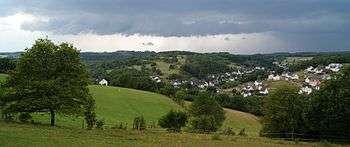Siegerland

The Siegerland is a region of Germany covering the old district of Siegen (now part of the district of Siegen-Wittgenstein in North Rhine-Westphalia) and the upper part of the district of Altenkirchen, belonging to the Rhineland-Palatinate adjoining it to the west.
Geologically, the Siegerland belongs to the Rheinisches Schiefergebirge (Rhenish Slate Mountains). The point of highest elevation is the Riemen, at 678 metres above sea level.
The region around the city of Siegen is centered in the middle of Germany. It includes the municipalities of Hilchenbach, Netphen, Kreuztal, Freudenberg and Siegen, and the communities of Wilnsdorf, Burbach and Neunkirchen, all in North Rhine-Westphalia, and in the Rhineland-Palatinate the municipalities of Kirchen, Herdorf and Betzdorf, with the community of Daaden. The population is approximately 300,000.
Iron mining and working began in Siegerland in 600 BC (cf the blast furnace at Wilnsdorf, dated to 500 BC) and continued until 1965, when the closing of Grube Georg (Georg Pit) in Willroth on March 29 ended over 2,500 years of mining. Characteristic of the area are the coppices (Hauberge) for the production of wood for charcoal burning.
The area now promotes its tourism industry and its capacities as a source of minerals and fossils. There is also a strong metal working industry today.
External links
| Wikimedia Commons has media related to Siegerland. |
- Siegerland: general and tourist information (German)
- History of the coppices, or Hauberge (German)
- Information on and history of local mining (German)
This article is based on the German Wikipedia article
Coordinates: 50°51′N 7°58′E / 50.850°N 7.967°E